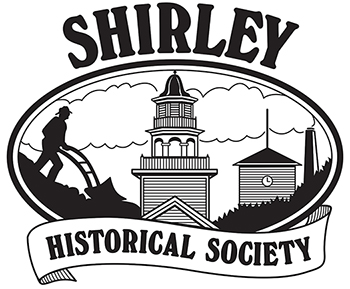A Brief Introduction to Shirley Center
The Town of Shirley is in the westernmost part of Middlesex County and was originally part of the town of Groton. The first settlements were in the 1720’s, along the Mulpus Brook and Catacunemaug Brook where early grist mills and saw mills were soon erected to provide for the settlers.
Incorporated in 1753, the hill in the geographic center of the district was chosen as the spot to erect the first meetinghouse, training field, and burial ground for the new town. The 18th century animal pound and burial ground still remain at the edge of the Common, but the church has been moved. For its first seventy years, the meetinghouse was literally in the middle of the common where the Civil War statue now stands. In 1851 it was moved, by oxen, to the edge of the Common, in order to enlarge the training field area. Side porches were later removed and a vestry was added to the bell tower entrance.
In the early nineteenth century, around this Center Common were built the homes of Shirley’s leaders, businessmen, and preachers. By 1850, the Town Hall was built and soon the Common achieved the appearance it has today. The Shirley Center Historic District is on the National Register of Historic Places so that buildings and landscape are protected from inappropriate additions or modifications. The Center has been so successful in maintaining its appearance, that it was chosen as an example of a perfect old New England Village for the 1938 World’s Fair film, The City. It was also used as the example of early New England Village architecture in the text book The Architecture of America by Buchard and Bush-Brown.
In the late nineteenth and early twentieth century, wealthy businessmen and intellectuals, who wanted to escape the city for the summer, bought some of the old Yankee houses on the lovely country hillside at Shirley Center. There were shoe manufacturers, painters, book collectors, museum archivists, lawyers, antiques collectors, writers, pianists, conservationists, and others who would plan summer entertainments and lyceum discussions at the old Town Hall. Many of the “Center Summer Folk” decided to stay in Shirley full time and have added a new intellectualism to the old farming area.
In the year 2000, much of Shirley Center still has the look of a mid-nineteenth century Town Common. The telephone and power lines have been placed underground. The trees and houses invite one to stroll and visit. The Meetinghouse and Town Hall sit facing the Common. Although it has no regular congregation, the Meetinghouse is frequently used for weddings, entertainments and ecumenical services. Go to http://www.shirleymeetinghouse.org/ Although it no longer has governmental offices, the Town Hall still hosts the Grange, the Scouts, a dance group, and other activities. Contact CTH Chairman Jodie Rachman at grovehouse@comcast.net. The cemetery, with its stone walls and iron enclosures, still sits across the street from the church and invites the visitor to pause awhile and enjoy the peaceful surroundings.
For more information about Shirley Center, her people, buildings, or landscapes, contact the Shirley Historical Society at 978-425-9328 or mail@shirleyhistory.org.
